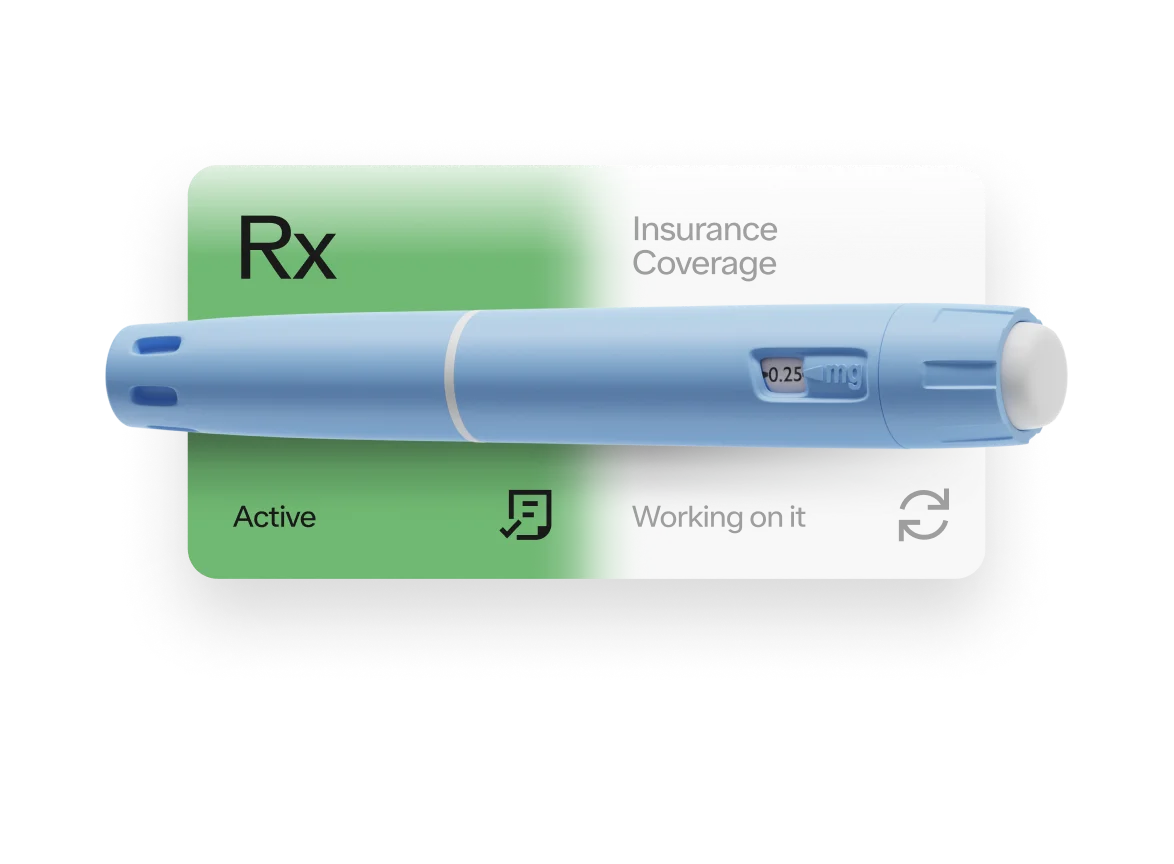Key takeaways
Joint pain is not a common side effect of Ozempic, although some individuals may experience it.
Ozempic joint pain may actually be caused by underlying health conditions, such as arthritis, or other medications that treat diabetes or cholesterol.
Ozempic muscle pain is also not a common side effect of Ozempic, and may be explained instead by dehydration, exercise, or injection site reactions.
Here's what we'll cover
Here's what we'll cover
Here's what we'll cover
Key takeaways
Joint pain is not a common side effect of Ozempic, although some individuals may experience it.
Ozempic joint pain may actually be caused by underlying health conditions, such as arthritis, or other medications that treat diabetes or cholesterol.
Ozempic muscle pain is also not a common side effect of Ozempic, and may be explained instead by dehydration, exercise, or injection site reactions.
Ozempic (semaglutide), the type 2 diabetes drug that can be prescribed off-label for weight loss, is known for a range of side effects, from abdominal pain to “Ozempic butt.” Usually, Ozempic doesn’t cause joint and muscle pain, although some people report it while taking the drug. Below, we explain what could be behind your aches and pains on Ozempic and what you can do about it.
Can Ozempic cause joint pain?
No, Ozempic probably doesn’t cause joint pain. In fact, in one clinical trial, joint pain was actually less common among the people taking Ozempic than those taking a placebo. Back pain was reported by trial participants, but the incidence was essentially equal between Ozempic and the placebo.
Can Ozempic cause muscle pain?
No, Ozempic probably doesn’t cause muscle pain. In clinical trials of the drug, participants taking Ozempic did not report significant muscle pain. Ozempic works by mimicking a gut hormone called glucagon-like peptide-1 (GLP-1) that slows down digestion. As a result, the majority of Ozempic’s side effects are digestive in nature, with the most common being nausea, vomiting, diarrhea, abdominal pain, and constipation. Other side effects can occur, but they are much rarer.
What could cause muscle and joint pain on Ozempic?
While Ozempic is not known to cause muscle or joint pain, that doesn’t mean that you can’t experience it while taking the drug. It simply means that your symptoms may be due to another cause rather than being directly linked to the medication. Some possible explanations for Ozempic joint pain or muscle pain include:
Underlying health conditions. Joint pain can be associated with various health conditions, including autoimmune disorders, bursitis, gout, and osteoarthritis. Osteoarthritis is a type of arthritis that commonly affects the joints in the hands, hips, and knees. It also tends to overlap with both obesity and type 2 diabetes — both conditions for which people may take Ozempic. Solution: Contact your healthcare provider to determine if your joint pain on Ozempic could be a warning sign of an underlying health issue.
Other medications. Certain medications can cause muscle or joint pain. This includes statins, which treat high cholesterol, as well as other diabetes drugs, such as DPP-4 inhibitors like Januvia (sitagliptin). Solution: Ask your healthcare provider if they can prescribe alternative medications with a lower risk of joint or muscle pain.
Injection site pain. Ozempic is administered weekly via a subcutaneous (under the skin) injection in the abdomen, thigh, or upper arm. Repeatedly injecting in the same place can cause a lump of fatty tissue to build up in that spot, possibly leading to muscle pain and even affecting the absorption of the medication. Solution: Rotate through the injection sites each week and avoid injecting Ozempic in the exact same place repeatedly.
Dehydration. Ozempic side effects like nausea, diarrhea, and vomiting can lead to dehydration. GLP-1s can also mess with your body’s ability to sense thirst. Besides darker urine and headache, dehydration can cause muscle cramps, which may explain muscle pain on Ozempic. Solution: Make sure to hydrate. You can do this by drinking more water and electrolyte-rich beverages, or sucking on ice cubes.
Exercise. Ozempic is meant to be used in combination with lifestyle changes such as diet and exercise. If you’re new to working out or have recently upped the intensity of your routine, you may experience muscle pain on Ozempic. Typically, this type of muscle soreness resolves on its own as your body recovers and becomes stronger. Solution: Work with a personal trainer or physical therapist to design a workout routine that reduces your risk of getting injured. If your muscle pain doesn’t go away, talk to a healthcare provider in case it’s due to an underlying injury.
5 things to try to relieve Ozempic joint pain
Here are five things to try if you’re experiencing Ozempic joint pain.
1. Contact your healthcare provider
If you’re experiencing persistent joint pain on Ozempic, your first step should be to make an appointment with your healthcare provider. They can help you understand what’s causing your Ozempic joint pain and recommend a treatment plan — whether that involves treating an underlying condition, adjusting your medications, or continuing to lose weight.
2. Treat underlying conditions
If an underlying condition is causing your Ozempic joint pain, treating that condition may offer relief. For example, losing weight may be recommended to people with obesity and osteoarthritis. Studies of individuals with knee osteoarthritis have shown that those who lose at least 10% of their body weight experience significant pain relief and improved functioning. If you’re not losing much weight while taking Ozempic, consider asking your healthcare provider about switching to another diabetes medication that supports weight loss, such as Mounjaro (tirzepatide).
3. Continue your Ozempic treatment plan, including diet and exercise
Taking Ozempic as directed — which includes exercise and a healthy diet — can lead to weight loss and increased muscle strength, both of which can relieve Ozempic joint pain. Weight loss can relieve the pressure on the joints, while exercise can help build up the muscles around them, providing further relief. In particular, losing body fat may relieve muscle and joint pain in the back, knee, and foot. And, research shows that people who lose weight by eating better and moving their bodies more — rather than just focusing on one or the other — experience the greatest pain relief.
4. Try over-the-counter pain medication
Mild joint pain can typically be relieved by over-the-counter medications, such as acetaminophen (Tylenol), ibuprofen (Advil, Motrin), and aspirin. If you’re taking any prescription medications, ask your healthcare provider which of these is the best pain relief option for you. Some target soreness, while others target pain and swelling, and it’s important to make sure that the pain relief drug you choose doesn’t interact with anything else you’re taking.
5. Give your body some TLC
Relieving Ozempic joint pain can be as simple as giving yourself some good ol’ TLC. Rest when you need to and avoid over-exerting yourself. And, try the following expert-backed methods for joint pain relief:
Warm baths
Massage
Gentle stretching
Ice therapy
Elevating your joints
Ozempic joint pain treatment: when to speak to your healthcare provider
It’s always a good idea to consult a healthcare provider if you’re experiencing symptoms you didn’t expect, such as muscle and joint pain on Ozempic. But, here are some specific situations when you should reach out:
You’re experiencing symptoms like swelling or warmth around the joint
Your joint isn’t moving like it used to
You can’t move the joint without experiencing pain
You’ve recently started taking a new medication
Your Ozempic joint pain isn’t going away
Do other weight loss drugs cause joint and muscle pain?
Generally, GLP-1 weight loss injections are not known for causing joint or muscle pain. Zepbound (tirzepatide) does not cause joint or muscle pain. The same goes for Wegovy, which contains the same active ingredient as Ozempic (semaglutide) but in higher dosage strengths. In clinical trials of Wegovy, people taking Wegovy were actually less likely to report joint pain than those taking a placebo.
One exception is Saxenda (liraglutide). In clinical trials, pediatric participants (aged 12–17 years old) taking Saxenda were almost twice as likely to report “pain in extremity” than those taking a placebo. However, this pain was still rare: affecting only 4% of adolescents taking Saxenda vs. 2.4% of those on a placebo. Additionally, the researchers didn’t specify whether the pain was specifically joint pain or another type of pain affecting their limbs.
If you’re experiencing muscle or joint pain on Ozempic, it’s worth talking to your healthcare provider about whether another medication could be a better fit for you.
Bottom line
If you’re experiencing joint or muscle pain while taking Ozempic, it’s likely not due to the drug itself. But it’s still worth bringing up to your healthcare provider. They can help you determine what’s actually behind the symptoms and help you navigate a treatment plan to achieve relief.
Muscle and joint pain are not common side effects of Ozempic. In clinical studies, people were less likely to experience joint pain on Ozempic vs. a placebo.
Ozempic joint or muscle pain may be due to underlying health conditions, other medications, injection site pain, dehydration, or increased exercise.
Relieving Ozempic joint pain should start with contacting your healthcare provider and treating underlying conditions. Losing weight, over-the-counter medications, and rest and relaxation can also help.
DISCLAIMER
If you have any medical questions or concerns, please talk to your healthcare provider. The articles on Health Guide are underpinned by peer-reviewed research and information drawn from medical societies and governmental agencies. However, they are not a substitute for professional medical advice, diagnosis, or treatment.
Ozempic Important Safety Information: Read more about serious warnings and safety info.
GLP-1 Important Safety Information: Read more about serious warnings and safety info.
Mounjaro Important Safety Information: Read more about serious warnings and safety info.
Zepbound Important Safety Information: Read more about serious warnings and safety info.
Wegovy Important Safety Information: Read more about serious warnings and safety info.
References
Canadian Agency for Drugs and Technologies in Health. (2019). Clinical Review Report: Semaglutide (Ozempic): (Novo Nordisk Canada Inc.): Indication: For the treatment of adult patients with type 2 diabetes mellitus to improve glycemic control, in combination with metformin (second-line treatment), and in combination with metformin and sulfonylurea (third-line treatment). Retrieved from https://www.ncbi.nlm.nih.gov/books/NBK544016/
Dunlevy, C., MacLellan, G. A., O'Malley, E., et al. (2019). Does changing weight change pain? Retrospective data analysis from a national multidisciplinary weight management service. European Journal of Pain (London, England), 23(8), 1403–1415. doi: 10.1002/ejp.1397. Retrieved from https://pubmed.ncbi.nlm.nih.gov/30963658/
Gilbert, M. P. & Pratley, R. E. (2020). GLP-1 Analogs and DPP-4 Inhibitors in Type 2 Diabetes Therapy: Review of Head-to-Head Clinical Trials. Frontiers in Endocrinology, 11, 178. doi: 10.3389/fendo.2020.00178. Retrieved from https://www.ncbi.nlm.nih.gov/pmc/articles/PMC7145895/
Hirsch, L. J. & Strauss, K. W. (2019). The Injection Technique Factor: What You Don't Know or Teach Can Make a Difference. Clinical Diabetes: A Publication of the American Diabetes Association, 37(3), 227–233. doi: 10.2337/cd18-0076. Retrieved from https://pmc.ncbi.nlm.nih.gov/articles/PMC6640874/
Kim, J. & Yoon, J. H. (2021). Does Obesity Affect the Severity of Exercise-Induced Muscle Injury?. Journal of Obesity & Metabolic Syndrome, 30(2), 132–140. doi: 10.7570/jomes20100. Retrieved from https://www.ncbi.nlm.nih.gov/pmc/articles/PMC8277587/
MedlinePlus. (2023). Dehydration. Retrieved from https://medlineplus.gov/ency/article/000982.htm
MedlinePlus-a. (2024). How to take statins. Retrieved from https://medlineplus.gov/ency/patientinstructions/000748.htm
MedlinePlus-b. (2024). Joint pain. Retrieved from https://medlineplus.gov/ency/article/003261.htm
Messier, S. P., Mihalko, S. L., Legault, C., et al. (2013). Effects of intensive diet and exercise on knee joint loads, inflammation, and clinical outcomes among overweight and obese adults with knee osteoarthritis: the IDEA randomized clinical trial. JAMA, 310(12), 1263–1273. doi: 10.1001/jama.2013.277669. Retrieved from https://pubmed.ncbi.nlm.nih.gov/24065013/
Nakhleh, A., Shehadeh, N., & Mansour, B. (2024). GLP-1 receptor agonists may enhance the effects of desmopressin in individuals with AVP deficiency: a case series and proposed mechanism. Pituitary, 27(5), 731–736. doi: 10.1007/s11102-024-01451-7. Retrieved from https://pubmed.ncbi.nlm.nih.gov/39240512/
Okifuji, A. & Hare, B. D. (2015). The association between chronic pain and obesity. Journal of Pain Research, 8, 399–408. doi: 10.2147/JPR.S55598. Retrieved from https://www.ncbi.nlm.nih.gov/pmc/articles/PMC4508090/
Piva, S. R., Susko, A. M., Khoja, S. S., et al. (2015). Links between osteoarthritis and diabetes: implications for management from a physical activity perspective. Clinics in Geriatric Medicine, 31(1), 67–viii. doi: 10.1016/j.cger.2014.08.019. Retrieved from https://www.ncbi.nlm.nih.gov/pmc/articles/PMC4254543/
Riddle, D. L. & Stratford, P. W. (2013). Body weight changes and corresponding changes in pain and function in persons with symptomatic knee osteoarthritis: a cohort study. Arthritis Care & Research, 65(1), 15–22. doi: 10.1002/acr.21692. Retrieved from https://www.ncbi.nlm.nih.gov/pmc/articles/PMC3401342/
Rubino, D., Abrahamsson, N., Davies, M., et al. (2021). Effect of Continued Weekly Subcutaneous Semaglutide vs Placebo on Weight Loss Maintenance in Adults With Overweight or Obesity: The STEP 4 Randomized Clinical Trial. JAMA, 325(14), 1414–1425. doi: 10.1001/jama.2021.3224. Retrieved from https://www.ncbi.nlm.nih.gov/pmc/articles/PMC7988425/
Rubino, D. M., Greenway, F. L., Khalid, U., et al. (2022). Effect of Weekly Subcutaneous Semaglutide vs Daily Liraglutide on Body Weight in Adults With Overweight or Obesity Without Diabetes: The STEP 8 Randomized Clinical Trial. JAMA, 327(2), 138–150. doi: 10.1001/jama.2021.23619. Retrieved from https://www.ncbi.nlm.nih.gov/pmc/articles/PMC8753508/
U.S. Food & Drug Administration (FDA-a). (2025). Highlights of Prescribing Information: Ozempic (semaglutide) injection, for subcutaneous use. Retrieved from https://www.accessdata.fda.gov/drugsatfda_docs/label/2025/209637s035,209637s037lbl.pdf
US Food and Drug Administration (FDA-b). (2025). Highlights of Prescribing Information: Saxenda (liraglutide) injection, for subcutaneous use. Retrieved from https://www.accessdata.fda.gov/drugsatfda_docs/label/2025/206321s022lbl.pdf
US Food and Drug Administration (FDA-c). (2025). Highlights of Prescribing Information: Wegovy (semaglutide) injection, for subcutaneous use. Retrieved from https://www.accessdata.fda.gov/drugsatfda_docs/label/2025/215256s024lbl.pdf
US Food and Drug Administration (FDA-d). (2025). Highlights of Prescribing Information: Zepbound (tirzepatide) injection, for subcutaneous use. Retrieved from https://www.accessdata.fda.gov/drugsatfda_docs/label/2025/217806s031lbl.pdf
Veronese, N., Cooper, C., Reginster, J. Y., et al. (2019). Type 2 diabetes mellitus and osteoarthritis. Seminars in Arthritis and Rheumatism, 49(1), 9–19. doi: 10.1016/j.semarthrit.2019.01.005. Retrieved from https://www.ncbi.nlm.nih.gov/pmc/articles/PMC6642878/
Walsh, T. P., Arnold, J. B., Evans, A. M., et al. (2018). The association between body fat and musculoskeletal pain: a systematic review and meta-analysis. BMC Musculoskeletal Disorders, 19(1), 233. doi: 10.1186/s12891-018-2137-0. Retrieved from https://www.ncbi.nlm.nih.gov/pmc/articles/PMC6052598/
Weiss, E. P., Jordan, R. C., Frese, E. M., et al. (2017). Effects of Weight Loss on Lean Mass, Strength, Bone, and Aerobic Capacity. Medicine and Science in Sports and Exercise, 49(1), 206–217. doi: 10.1249/MSS.0000000000001074. Retrieved from https://www.ncbi.nlm.nih.gov/pmc/articles/PMC5161655/














